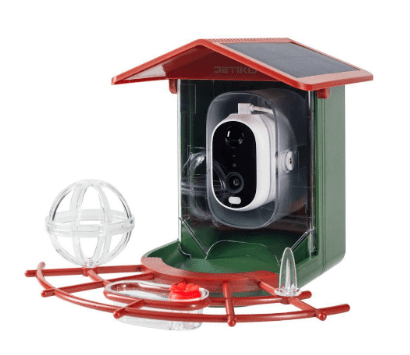Living With the DETIKO Smart Bird Feeder

There are smart cameras, and there are bird feeders. I never thought I’d need something that’s both, until I spent a few weeks with the DETIKO Smart Bird Feeder sitting quietly in my garden.
At first glance, it looks charmingly simple: a bright red-and-green body with a compact solar roof, perched like a little house under the morning light. But underneath, this device is surprisingly sophisticated: it features AI recognition, motion detection, app alerts, and even its own database that can tell a robin from a finch in seconds. It’s like having a wildlife photographer and ornithologist on standby, twenty-four hours a day.
Set Up and First Impressions
The ABS Edition has a smooth plastic shell and a built-in solar panel. I hung mine on an old oak branch, partly shaded, and it took less than ten minutes to get it running. Once powered on and connected to Wi-Fi, the setup went smoothly with barely a hiccup.
The solar panel charges a 5200 mAh battery, which is supposed to last around two months. I didn’t push it that far, but even after weeks of gloomy weather, the battery icon never dipped below halfway.
It took about a day for the birds to get curious, and by the weekend, my phone started lighting up with notifications. I opened the app, and there they were, sparrows arguing over seeds, crystal-clear in the 2K video feed. The 147-degree lens provided a panoramic view of the branch and the feeder below, with colors that were more natural than I expected. Even at dusk, the built-in night mode handled the dim light beautifully.
The feeder ships with multiple feeding modules, so I experimented, sunflower seeds one day, chopped fruit the next. Later, I even filled one with nectar to see if I could lure hummingbirds.
AI That Feels Alive
What truly sets DETIKO apart is its AI. Every time a bird visits, it takes a short clip and tags the species. I didn’t have to lift a finger. One morning, I watched the app create a little “card” for a blue jay, complete with name, timestamp, and short description. There’s something oddly satisfying about scrolling through a log of every visitor that’s come by, like flipping through a digital bird diary.
One thing I really appreciate is that the footage and data stay on U.S.-based servers, and you can also store everything locally on an SD card. The app itself feels clean, without the overcomplicated menus that plague so many smart-home gadgets.
It also works on both iOS and Android. I used it on my phone and my partner’s tablet simultaneously, and we could both watch the same live feed. We even turned it into a little morning ritual: coffee in one hand, birds on the screen (sometimes even deer).
In the Rain, the Snow, and the Night
There’s a thoughtfulness in small details here. The design feels solid, not fragile. The roof keeps most of the rain off the feed. Over the weeks, we had rain, wind, and the feeder didn’t flinch. It’s rated IP65 and built to handle everything from –10 °C to 55 °C. The lens stayed clear, the solar panel kept charging, and the birds kept coming. Even the night vision footage had a quiet magic to it.
Priced at $149.99, you can purchase the product now through Amazon.



